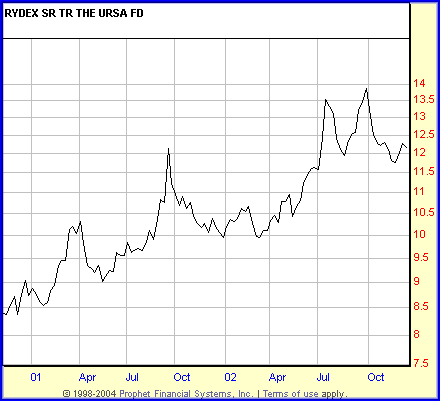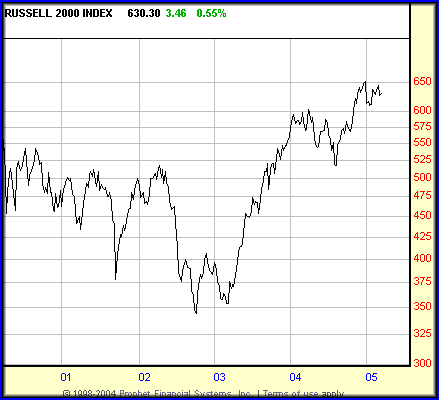
HOT TOPICS LIST
- Strategies
- Stocks
- Buy
- Investing
- Brokers
- Psychology
- Interviews
- Accumulate
- Sell
- Hold
- Spotlight
- Websites
- Candlestick Corner
- Gold & Metals
- Options Trading
LIST OF TOPICS
VIEWS FROM THE FIELD
John McClure Of EquiTrend
03/16/05 12:43:36 PM PSTby David Penn
Market timing helps keep traders swimming with the current, not against it. What is your market timing strategy doing for you?
| If ever there were a case of making lemonade out of lemons, then the story of John McClure and EquiTrend would most certainly qualify. McClure had spent a good chunk of the bull market 1990s developing a market timing algorithm for trading, yet by the time his algorithm was ready for prime time availability to retail-level traders and investors, that glorious bull market had metastasized into a fairly inglorious bear market. Bad news for EquiTrend? Not hardly. "We don't forecast," McClure said in a recent telephone conversation. "An email every day, one day at a time." That's how EquiTrend advised its members during the bear markets of 2001 and 2002, and every day since: through the heady bull market of 2003, the saw-toothed bear market of 2004 and into the "mystery meat" market of 2005. By not being preoccupied with anticipating market moves months, weeks, or even days in advance, and instead taking the market one day at a time, McClure believes EquiTrend members will end up being on the right side of the market most of the time, including being on the right side of the market when it makes its biggest moves. McClure began his quest to build a better market timing mousetrap back in the early 1990s. He admitted to being motivated in part by his amazement that banks, some of the most conservative institutions in the modern economy, regularly lent out billions of dollars based on an algorithm (FICO, or Fair Isaac Corp. credit score). After completing work on his market timing algorithm in the mid-1990s, McClure spent a few years advising institutional and professional clients before deciding to diversify his revenue stream in the late 1990s. EquiTrend has been providing real-time directional market signals to its retail members since the summer of 2001. The year "2001 was a good time for what we do because there was a lot of movement," McClure notes, "large moves up and large moves down. Invert a bear market and it would be a beautiful bull market."
Timing Trumps "Thinking"Working with a mechanical market timing algorithm has provided McClure with interesting insights into some of what prevents average retail traders and investors from being more successful in the markets. The psychology of the average retail investor "is completely the opposite of the way it should be," McClure explained. "The retail investor would rather outperform a bull market and lose money in a bear market." Instead of looking to keep pace with a bull market and make money in a bear market, as institutional and professional investors and traders seek to do, McClure points out that the average investor in a bull market is too concerned with keeping up with the guy at the watercooler who is bragging about the crazy return on his go-go fund, while at the same time not minding losing thousands during the bear market periods because then he can commiserate with that same guy at the watercooler who is now broke. "Misery loves company," McClure said.
Figure 1: Bearish and inverse market mutual funds such as this one, the Ursa fund from Rydex, are part of EquiTrend's strategy of making money in bear markets as well as bull markets.
This led to an interestingly candid admission by McClure with regard to the news and commentary EquiTrend has been providing its members recently (see "EquiNews Week" at EquiTrend.com for samples). EquiNews Week takes a regular look at a variety of economic, financial, technical, and sociopolitical factors that could be affecting the markets. One week the discussion may be about interest rates and the Federal Reserve, another week tax loss selling, and still yet another about oil prices or sentiment extremes. How does EquiTrend as a market timing system factor in all of this diverse information in producing profitable buy and sell signals? The short answer is one every technical analyst knows by heart: It doesn't. But McClure's explanation was refreshing in its candor: "It's just noise," he said. "But people want to know how we perceive things, how we think." At the end of the day, however, this "noise," as McClure admits, is really geared toward feeding the "emotional psyche of our clients." Maybe that's a little tough, but coming from a man who says that the only thing worse than losing money "is losing a lot of money," those are words worth keeping in mind the next time some mainstream financial expert says that he is hearing "chatter" about an impending takeover or the next time some CEO goes into overtime talking up his stock in a television interview. "We are quantitative," said McClure, "and follow our signals. But we pay attention to news that hasn't been factored" to the markets. An example he gives would be a significant terrorist event over a weekend after the markets closed on Friday. A buy signal on Friday may or may not be honored on the following Monday morning.
Trading With EquiTrendWith a reference to the markets in more recent times, McClure admitted that the "slop and chop market is difficult for everybody." While that did not stop EquiTrend from making timely bearish and bullish calls in late December 2004 and late January 2005, respectively, it does highlight the dangers of being distracted by both the noise of the market and the need for any market timing strategy to be both nimble and flexible when trying to stay on the right side of the market's strongest trends. Whether those strongest trends are headed upward or downward is of little consequence to EquiTrend, but the strength of those currents certainly is. To this end, EquiTrend encourages the use of trading and investment vehicles that are best poised to take advantage of market volatility — whether that volatility is to the upside or downside. Asked, for example, about EquiTrend's focus on small-cap and technology exchange-traded and bear funds, McClure replied that when the Dow Jones industrials are leading the market, "the market is probably unhealthy." Russell 2000 and Nasdaq have been the centers of growth in the markets for years, he said. As such, they can be the best place to be when the market is moving higher — and the worst place to be when the market is moving lower.
Figure 2: The greater volatility of smaller stocks in the Nasdaq 100 and Russell 2000 enables active managers to take the maximum advantage of market moves.
A market-timing strategy that allows for long and short positioning is best poised to take advantage of this. For those members of EquiTrade who invest and position trade primarily through IRA accounts, the combination of exchange-traded funds (ETFs) and bear funds like those available through the Rydex family let average retail investors take full advantage of the long and short swings in the market. Suggested McClure, "An investor or trader may use ETFs to go long, but because of the restrictions on retirement accounts, (the investor) may use the Rydex funds instead of going short." EquiTrend offers a free newsletter and two "trial versions" — a 30-day "free trial" arrangement and a 30-day money-back guarantee full membership — for those who are interested or even just curious about the work they've been doing over the past few years. While memberships are currently handled on a month-to-month basis, annual memberships are likely to be offered in the near future. EquiTrend members are a variegated bunch, including average investors, part-time traders, and serious traders. Many use EquiTrend exclusively, while others use EquiTrend to inform their own technical or fundamental analysis of the markets. For example, while EquiTrend focuses on indexes such as the Nasdaq and Russell 2000, a trader using EquiTrend signals as a guide could use these signals as indications to take long or short positions in leading stocks that are in these indexes. Even followers of other trading systems may have a lot to gain by investigating what EquiTrend has to offer. Observed McClure: "There are a lot of trading systems out there, but if they haven't factored in a market timing mechanism, they're leaving dollars on the table. Having a general sense of the direction the current is going is important. Swimming against the current is always a difficult thing to do."
David Penn may be reached at DPenn@Traders.com.
Current and past articles from Working Money, The Investors' Magazine, can be found at Working-Money.com.
|
Technical Writer for Technical Analysis of STOCKS & COMMODITIES magazine, Working-Money.com, and Traders.com Advantage.
| Title: | Traders.com Technical Writer |
| Company: | Technical Analysis, Inc. |
| Address: | 4757 California Avenue SW |
| Seattle, WA 98116 | |
| Phone # for sales: | 206 938 0570 |
| Fax: | 206 938 1307 |
| Website: | www.traders.com |
| E-mail address: | DPenn@traders.com |
Traders' Resource Links | |
| Charting the Stock Market: The Wyckoff Method -- Books | |
| Working-Money.com -- Online Trading Services | |
| Traders.com Advantage -- Online Trading Services | |
| Technical Analysis of Stocks & Commodities -- Publications and Newsletters | |
| Working Money, at Working-Money.com -- Publications and Newsletters | |
| Traders.com Advantage -- Publications and Newsletters | |
| Professional Traders Starter Kit -- Software | |
PRINT THIS ARTICLE

|

Request Information From Our Sponsors
- VectorVest, Inc.
- Executive Premier Workshop
- One-Day Options Course
- OptionsPro
- Retirement Income Workshop
- Sure-Fire Trading Systems (VectorVest, Inc.)
- Trading as a Business Workshop
- VectorVest 7 EOD
- VectorVest 7 RealTime/IntraDay
- VectorVest AutoTester
- VectorVest Educational Services
- VectorVest OnLine
- VectorVest Options Analyzer
- VectorVest ProGraphics v6.0
- VectorVest ProTrader 7
- VectorVest RealTime Derby Tool
- VectorVest Simulator
- VectorVest Variator
- VectorVest Watchdog
- StockCharts.com, Inc.
- Candle Patterns
- Candlestick Charting Explained
- Intermarket Technical Analysis
- John Murphy on Chart Analysis
- John Murphy's Chart Pattern Recognition
- John Murphy's Market Message
- MurphyExplainsMarketAnalysis-Intermarket Analysis
- MurphyExplainsMarketAnalysis-Visual Analysis
- StockCharts.com
- Technical Analysis of the Financial Markets
- The Visual Investor


